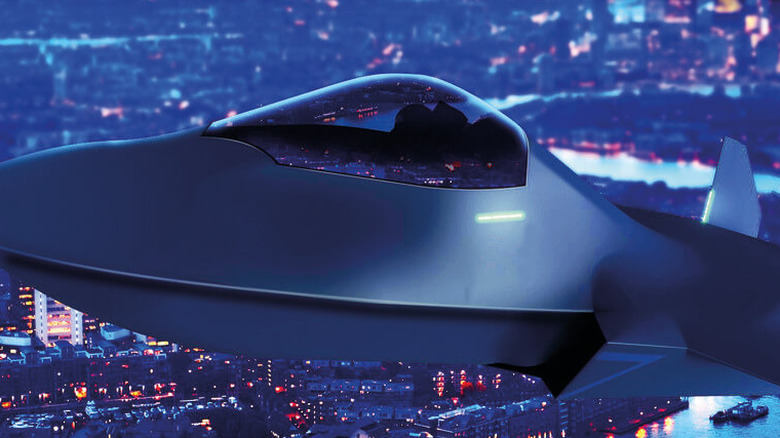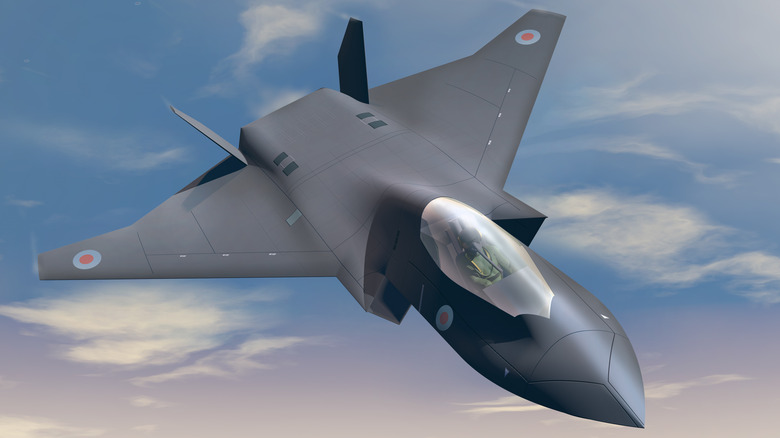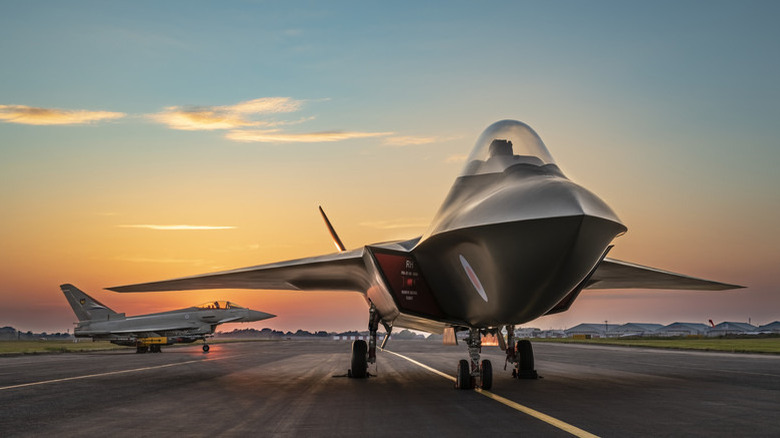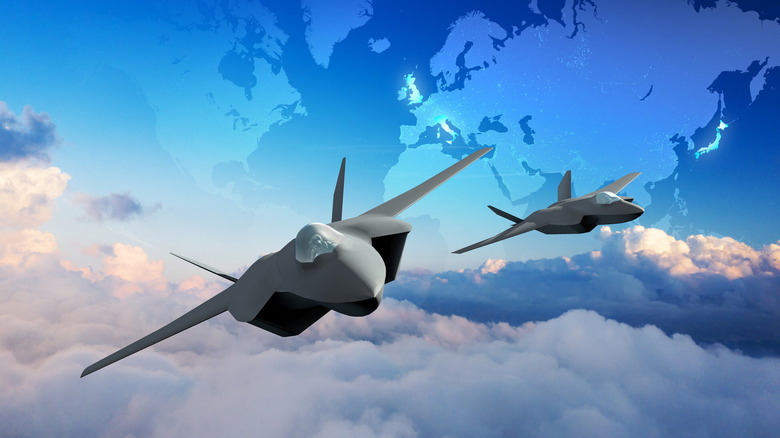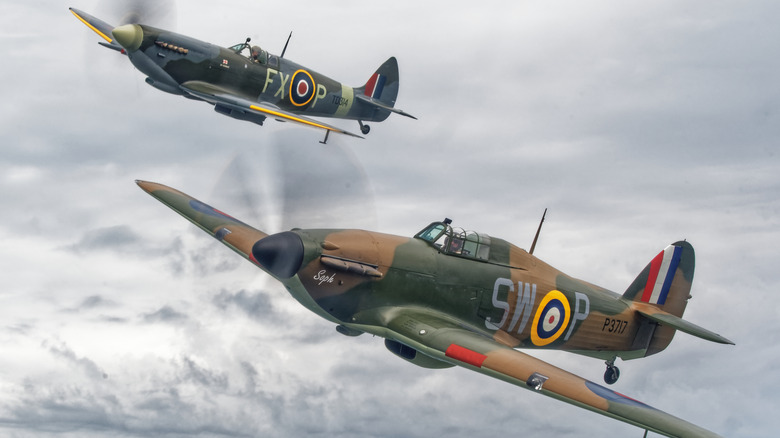Everything We Know About The Royal Air Force's 6th-Gen Fighter Jet
Britain's sixth-generation fighter may be over a decade away, but we already know a lot about the Royal Air Force's plans to meet the aerial combat needs of the future. The project is expected to cost the U.K. over £10 billion ($12.5 billion) between now and then. But the British Government will be getting a lot for its money. It will be capable of flying itself, hitting supersonic speeds, and deploying a range of cutting-edge weaponry. The Tempest won't be the only sixth-generation fighter in the sky. Most of the world's leading military powers, including the United States, are working on their own next-gen aircraft.
The Tempest is set to replace Britain's stock of Eurofighter Typhoons, which are Generation 3.5 fighters. The Typhoon's development began way back in the 1980s, and the plane eventually entered service in 2003. With a good amount of its development occurring after the end of the Cold War, questions were raised over the necessity of the project. However, given the recent rise in global tensions, along with recent events including Russia's invasion of Ukraine, it's unlikely that the Tempest will face similar criticisms. It is set to be built in BAE's "factory of the future" located in North West England. If everything goes to plan, the Tempest will be taking to the air in 2035.
The Tempest will be modular, versatile, and easily upgradable
In an effort to make the next-generation fighter useful in a range of combat scenarios while also cutting costs, the RAF is taking a plug-and-play approach to its new jet. Software and components will be easy to remove and swap out with other parts and programming. This means the Tempest can be tailored to a task, and the Royal Air Force doesn't have to buy extra planes for niche applications. The RAF says, "This innovation removes the usual rigid structures of assembly and will make manufacturing more cost-effective and flexible than before."
The ability to easily modify the aircraft will also future-proof it to an extent. In addition to specialist parts, upgrading should also be a far easier process. So as new components are developed, they may be able to slot right into the aircraft. Examples of interchangeable modules the RAF gives include weapons, sensors, and fuel tanks — though the entire cockpit can also be switched out for an unmanned module should the mission requirements call for the jet to act as a large drone.
A familiar name is contributing the thrust
Rolls-Royce is arguably more famous for its ultra-luxurious cars, but like many automotive manufacturers, it also has strong links to the aviation industry. It made its first aircraft engine over a century ago, and the planes that won the Battle of Britain back in 1940 were all powered by a Rolls-Royce engine. The company is continuing this tradition by producing the jets that will give the next generation of British fighters their thrust.
The propulsion system is designed to optimize "overall performance, range, and payload capability," according to the company, while taking the jet well beyond the speed of sound. In addition to thrust, it will also produce more electrical power than previous systems. This is handy, as the advanced sensors have higher power demands than those used on older aircraft. A special cooling system also reduces the heat of the engines and in turn helps mask the plane's heat signature. This is one of the many features the Tempest has which should help it stay undetected.
Next-gen tech will be used
In addition to its engines and cutting-edge stealth technology that will keep it off enemy radars, the aircraft also has some impressive next-gen tech on the inside. Powerful machine learning AI is a key component of the next-gen fighter. This AI will be capable of flying the plane during unmanned missions, and will heavily assist the pilot when there is one. The on-board artificial intelligence will also make use of the information provided by the plane's many sensors, and can instantly communicate with other Tempests nearby. So coordinating actions between squadrons of aircraft will be easier and more effective.
Those sensors include a system of cameras that can provide a 360-degree view of what's going on around the aircraft, an advanced "AESA" Radar that is resistant to jamming, and an infrared system that is capable of detecting targets both in the air and on the ground. As far as offensive capabilities go, the Tempest will be able to deploy multiple drones to perform tasks and assist it in combat, launch hypersonic missiles at targets, and may even be armed with laser weapons.
The cockpit is also a very different environment in the Tempest. Pilots will be equipped with an "augmented reality" headset that will project displays and controls in front of them. Pilots will be able to interact with these projections, and it may remove the need for physical cockpit displays and controls altogether.
It's a joint effort, with three major countries on board
Just like the Eurofighter Typhoon and the F-35, the Tempest isn't something Britain is developing on its own. Instead, several other nations, including Japan and Italy, are all on board and contributing to the fighter's design. Japan's contribution will include the jet's avionics, radar, and computer systems, which are being developed by Mitsubishi. The Japanese manufacturer will also handle a chunk of the construction of jets destined for Japan's Air Force. The Asian nation's current fleet is predominantly made up of American planes, so the new aircraft will certainly stand out. Japan and the U.S. have a close military relationship, which includes the sale of fighter jets like the F-15 and F-35. It's understood that the United States has given its full blessing to the project, which involves several of its allies.
The project has been titled the Global Combat Air Program, and Japan may be one of the countries that benefit most from it. The island nation is close to both North Korea and China, and tensions with both of those countries are higher than they have been in years. Sweden may have similar concerns, given its proximity to Russia. It's understood that the Scandinavian country has an interest in joining the project, though it's uncertain if it will actually end up taking part.
It fits in with a long tradition
The name Tempest is pretty fitting for a combat aircraft. It's pretty aggressive and sums up an image of an unrelenting force of nature blowing in and dominating the sky. But that's probably not the only reason the new aircraft received its name. It's likely linked to the long tradition the RAF has of naming its fighter planes after extreme weather. This stretches back to World War 2. The Spitfire got all of the glory, but it was the Hawker "Hurricane" that actually did most of the work. At around the same time, Lockheed's P-38 was christened the "Lightning" once the RAF got its hands on a batch.
Amongst the many other weather-themed names the RAF has chosen for its fighter fleet is an example of history repeating itself. Just as the Tempest is set to replace the Eurofighter Typhoon in just over a decade, the Hawker Tempest replaced the Hawker Typhoon in 1944. So although the Tempest will be packed with cutting-edge technology when it eventually takes to the skies, it is still heavily intertwined with the history of the world's oldest air force.
